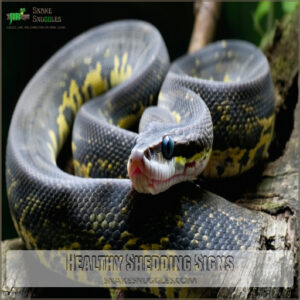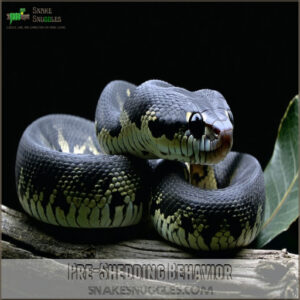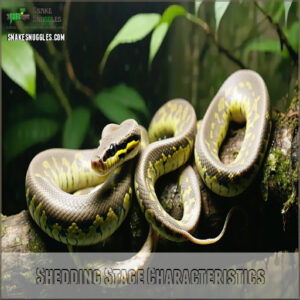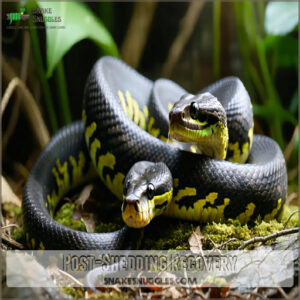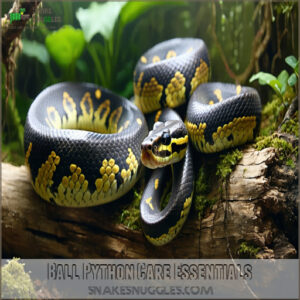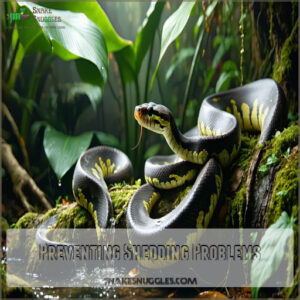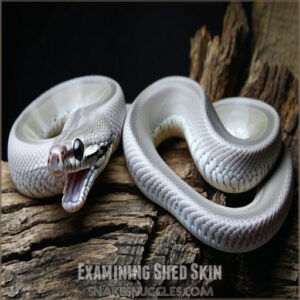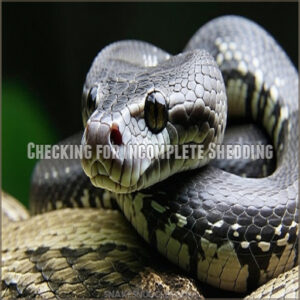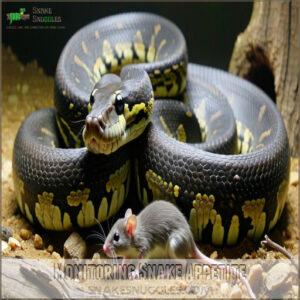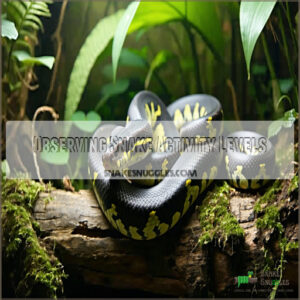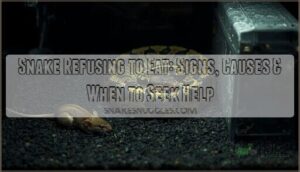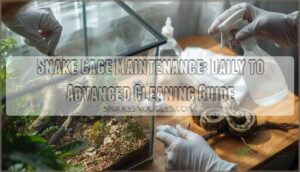This site is supported by our readers. We may earn a commission, at no cost to you, if you purchase through links.
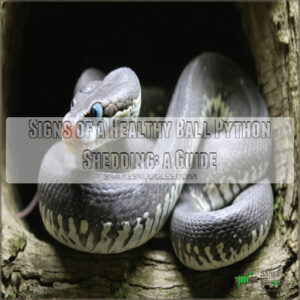 Healthy ball python shedding comes with clear signs, such as their eyes turning a cloudy blue—it’s like they’re wearing foggy goggles.
Healthy ball python shedding comes with clear signs, such as their eyes turning a cloudy blue—it’s like they’re wearing foggy goggles.
You’ll notice their vibrant scales look dull, almost like frosted glass, and their skin may feel loose or powdery, a pinkish belly is another clue, starting light and turning deeper as shedding approaches.
They’ll hide more often, preferring dark, snug spaces and avoiding handling, to help the process go smoothly, keep the humidity around 60-70% during this time.
Once their skin comes off in one neat piece, you know they’ve nailed it, curious about post-shed care, there’s more to learn!
Table Of Contents
Key Takeaways
- You’ll know your ball python’s ready to shed when its eyes turn cloudy blue, scales look dull, and its belly develops a pinkish hue.
- Increased hiding behavior and decreased appetite are typical during the shedding process, so give your snake space and avoid handling.
- Maintain proper humidity levels (60-70%) and provide rough surfaces or humidity boxes to help your snake shed its skin in one piece.
- After shedding, inspect the shed skin for completeness, check important areas like the eyes and tail, and monitor your snake’s appetite and activity for signs of good health.
Healthy Shedding Signs
You’ll notice your ball python’s getting ready to shed when its eyes turn cloudy and its skin becomes dull.
Your snake may also show a pinkish belly and spend more time hiding, which are normal signs of a healthy shedding process.
Cloudy Eyes Before Shedding
Your ball python’s cloudy vision is one of the first python shedding signs to watch for.
During this "blue phase," fluid builds up between old and new eye caps, making snake eyes appear milky blue.
This natural shedding prep typically starts 3-7 days before the actual shed.
Retained eye caps, also known as spectacles, can cause similar cloudiness and require attention.
For more information, consult this helpful resource on ball python eye problems.
Maintain proper humidity levels and watch for any eye infection signs that persist beyond normal shedding time.
Dull Skin Indicators
Just like those cloudy eyes, dull skin shows your ball python’s ready to shed.
This change in appearance turns your snake’s usually vibrant scales into a lackluster version of themselves.
These healthy shedding indicators also include behavioral changes like increased hiding.
Here’s what to watch for:
- Your snake’s bright patterns will look faded and muted
- The scales lose their typical shine and appear almost powdery
- Their skin might look slightly wrinkled or loose
- Colors appear washed out, like looking through frosted glass
Pinkish Belly Appearance
While your snake’s skin turns dull before shedding, you’ll notice another telltale sign – their belly takes on a pinkish hue.
This belly color change happens as the new skin forms underneath the old one.
| Belly Appearance | What It Means |
|---|---|
| Light Pink | Early shedding phase |
| Deep Pink | Mid-shedding phase |
| Slightly Red | Peak shedding time |
| Back to Normal | Shedding complete |
This pink belly phase typically lasts 2-3 days before the actual shed begins, indicating the snake is in a shedding phase.
Increased Hiding Behavior
During shedding, your ball python’s hiding behavior will increase markedly.
This natural behavioral change helps protect them while they’re vulnerable.
Watch for these signs of snake stress:
- Spending more time in their favorite hiding spots, especially dark corners
- Avoiding handling attempts more than usual
- Moving primarily at night to find new shelter spots
- Preferring enclosed spaces over open areas
- Retreating quickly when disturbed, showing heightened defensiveness
Remember, this social withdrawal is completely normal during the shedding process.
Shedding Process Stages
Your ball python will show distinct signs as it moves through the three main stages of shedding: pre-shed, active shed, and post-shed recovery.
You’ll notice changes in your snake’s appearance and behavior during each stage, from dulling skin and decreased appetite to the final moments when it sheds its old skin.
Pre-Shedding Behavior
Once you’ve noticed those initial signs of shedding, you’ll see some clear pre shed signs in your python’s behavior.
Environmental cues trigger a 7-day preparation period, where you’ll notice your pet spending more time hiding.
They’ll also skip meals and might seem a bit grumpy – don’t worry, it’s just part of their natural snake shedding cycle.
The entire shedding process typically takes 7-14 days, as detailed in this ball python shedding guide.
Watch for stress factors like excessive restlessness or unusual activity patterns, which can be a sign of a problem in the shedding process.
Shedding Stage Characteristics
Once your ball python’s eyes clear up, the active shedding cycle begins and typically lasts 72 hours.
During this time, you’ll notice skin removal starting near the head, with your pet rubbing against cage items to help the old skin peel away in one piece.
Keep humidity levels at 60-70% throughout this stage for ideal results, as this is crucial for the python shedding process to continue downward.
Post-Shedding Recovery
After your python completes its skin renewal process, you’ll notice its vibrant colors return within 24-48 hours.
During this post-shedding recovery time, your snake will gradually resume normal eating habits, and your healthy shedding companion might seem extra active, making up for lost time.
Remember to conduct health checks and monitor snake hydration levels, as a successful shed means your ball python’s looking fresh and feeling energized, which can be attributed to a successful shed and the fact that it’s a healthy shedding companion.
Ball Python Care Essentials
You’ll need a proper setup to keep your ball python healthy during shedding, including the right enclosure size and substrate choices.
Your snake’s home should maintain specific temperature ranges and lighting schedules, which directly affect how well they shed their skin.
Suitable Enclosure Size
Your snake’s home needs to match its size perfectly.
For a healthy ball python enclosure, follow this simple rule: multiply your snake’s length by 1.0 x 0.5 x 0.75 for the dimensions.
A 4-foot snake needs a 4′ x 2′ x 3′ space, while a 3-footer needs 36" x 18" x 27".
This habitat layout gives your pet room to move, climb, and thrive.
For more precise calculations, utilize a helpful ball python enclosure size calculator.
Appropriate Substrate Options
Your choice of substrate materials makes a huge difference in successful shedding.
Coconut fiber and cypress mulch excel at humidity control while supporting natural burrowing behavior.
For budget-friendly cage liners, paper towels offer easy cleaning and health monitoring.
Create a dedicated humidity hide box with sphagnum moss to aid shedding.
Bio-active soil provides the most natural environment but requires live plants.
For further choices, explore suitable ball python substrate products.
Temperature Gradient Requirements
Creating the right warmth levels starts with proper thermal controls.
Set your temperature gradient with a basking spot of 95-104°F and a warm hide between 86-90°F.
Your cool side should stay at 72-80°F, with nighttime temperatures dipping to 70-78°F.
Connect heat source options like ceramic heaters or heat lamps to a thermostat for consistent gradient maintenance.
UV Lighting Recommendations
Just like you control the temperature, proper UVB lighting transforms your ball python’s habitat into a health powerhouse.
Modern lighting options help regulate your pet’s natural day/night cycle while supporting vitamin D3 production.
Here’s what you need for ideal UVB setup:
- Install a reptile-specific UVB bulb with 290-320 nanometer wavelength
- Create a UVB gradient for basking choice
- Follow manufacturer’s specs for bulb height
- Monitor intensity levels monthly for effectiveness
Preventing Shedding Problems
You’ll find it much easier to prevent shedding problems than to fix them once they start, and your ball python will thank you for it.
Setting up the right humidity levels and providing clean water dishes are your best tools for keeping your snake’s shedding process smooth and problem-free, which involves maintaining the right environment for a healthy shed, and this is crucial for your ball python.
Maintaining Proper Humidity
Getting environmental control right starts with humidity levels.
Your ball python needs 55-70% humidity for healthy shedding.
Keep an eye on your hygrometer – if readings drop below 55%, you’ll risk dehydration and shedding problems.
A wide selection of ball python hygrometers are available online.
You can fine-tune snake humidity by adjusting substrate moisture and ventilation.
During shedding, bump it up to 70% to help your python shed like a pro .
Providing Shallow Water Dishes
Along with proper humidity levels, your ball python needs a clean, shallow water dish to support healthy shedding.
For a variety of suitable options, browse this selection of ball python water dishes.
Here’s what you need to know about Water Bowl Maintenance for ideal Snake Hydration:
- Keep the dish wide enough for your python to soak but shallow to prevent drowning
- Replace water daily to maintain Water Quality
- Position the bowl away from heat sources to reduce evaporation
- Clean the dish with reptile-safe disinfectant weekly
- Place it where it won’t tip during your snake’s shedding ball python process
This information is crucial for maintaining the health and well-being of your ball python, ensuring it has the best conditions for a healthy life.
Avoiding Handling During Shedding
While your ball python’s shallow water dish helps with shedding, hands-off care becomes your top priority now.
When you notice shedding signs, keep handling to absolute emergencies only.
Your snake’s new skin is sensitive, and touching them during this time adds unnecessary stress. Plus, they’re more likely to feel defensive when they can’t see clearly through their cloudy eyes.
Monitoring Snake Behavior
During shedding, keeping tabs on your snake’s behavior reveals key health indicators.
Watch for these behavioral changes that signal a healthy shed:
- Normal tongue flicking and occasional exploring, even if less frequent
- Seeking out rough surfaces to rub against
- Using the water dish more often for soaking
- Temporary decrease in activity and appetite
Remember: excessive stress signs like constant movement or complete inactivity need vet attention, and it is crucial to monitor for these signs to ensure the snake’s complete well-being.
Post-Shedding Health Checks
You’ll want to check your ball python carefully after it sheds to make sure everything went smoothly.
After shedding, your snake should have clear eyes, a bright and clean appearance, and show normal activity levels within a day or two, which indicates a successful shed and a healthy snake with normal activity levels.
Examining Shed Skin
After your python sheds, you’ll want to collect and inspect that cast-off skin – it’s like a health report card.
This skin should be spread out flat and checked for any holes, tears, or missing sections, as a healthy shed skin should be complete and in one piece, showing clear scale patterns throughout.
Look closely at areas around the head, eyes, and vent, as these spots often reveal potential problems, making it a crucial part of the inspection to ensure the overall scale patterns are intact.
Checking for Incomplete Shedding
Now that you’ve checked the shed skin, let’s make sure your snake isn’t dealing with any retained pieces.
Look closely at your ball python’s scales – incomplete shedding (dysecdysis) often shows up as patches of old skin stuck around the tail, head, or belly.
Retained eye caps can be tricky to spot, so check those eyes carefully.
If you notice any skin problems or shedding issues, your snake might need some extra humidity control.
Monitoring Snake Appetite
After checking the shed, pay attention to your snake’s appetite.
Appetite changes are normal right after shedding, but eating habits should stabilize quickly.
Look for signs of a healthy snake, like resuming regular food intake.
Loss of appetite beyond a week might mean deeper nutrition needs aren’t met.
Stick with feeding patterns, and monitor ball python health closely.
Observing Snake Activity Levels
A ball python’s energy tells a lot after shedding.
Watch for natural snake movement patterns returning to normal, including curiosity and smooth activity cycles.
If it’s sluggish or hiding excessively, check environmental factors like temperature or humidity.
Regularly consult a comprehensive snake health checklist for a detailed guide on recognizing potential health concerns.
Behavioral changes, like unusual stress signals or lethargy, could mean trouble.
Healthy shedding signs often include a calm, alert snake exploring confidently post-shed, indicating a return to normal behavior.
Frequently Asked Questions (FAQs)
How long does shedding typically take?
Shedding typically lasts a few days to a week.
You’ll notice early signs like dull skin and cloudy eyes, then the old skin comes off in one go if conditions like humidity are just right.
Can shedding frequency indicate overall health?
Shedding frequency offers clues about your snake’s health.
Frequent sheds in adults might mean growth or healing, but irregular or difficult shedding can signal issues like dehydration or poor husbandry.
Keep an eye on their patterns!
Do ball pythons shed at specific times of year?
Think of shedding like a snake’s version of spring cleaning—it’s not tied to specific seasons.
Ball pythons shed based on growth and health, so frequency depends on factors like age, diet, and environmental conditions.
How to handle stuck shed near the eyes?
Gently use a damp cotton swab to loosen stuck shed near the eyes, rolling it carefully without forcing.
Avoid pulling directly.
If it doesn’t budge, create a humidity chamber or consult an experienced reptile vet.
What enrichment items aid the shedding process?
Provide rough surfaces like driftwood, rocks, or even textured hides.
These give your snake spots to rub against and peel off that old skin.
A humidity box with damp moss can work wonders too!
Conclusion
Think of a ball python shedding like a fresh start—it’s their way of swapping an old “outfit” for a brand-new one.
Spotting signs of a healthy ball python shedding, like cloudy eyes and dull scales, confirms you’re keeping their environment just right.
Maintain humidity, offer a secure hide, and avoid handling to support shedding.
Afterward, inspect the shed skin for completeness and monitor their behavior.
With proper care, they’ll stay healthy and thrive in their environment.
- https://www.snakesforpets.com/shedding-process-of-ball-python/
- https://snakesinfo.com/ball-python-eyes-cloudy/
- https://www.terrariumquest.com/ball-python/eye-conditions/
- https://www.lizards101.com/ball-python-shedding-stages-signs-problems-eye-caps/
- https://ballpythonplanet.com/coco-coir-substrate-and-ball-python-shedding-what-you-need-to-know/

